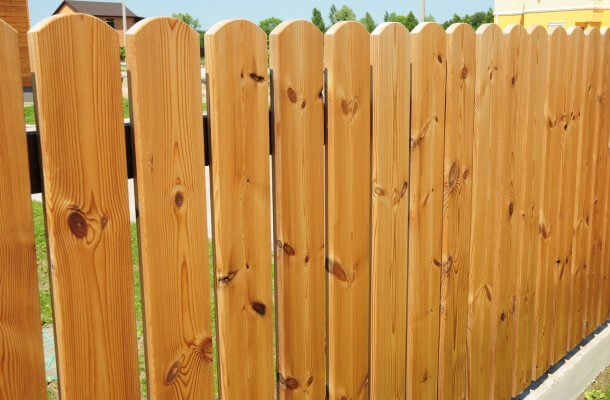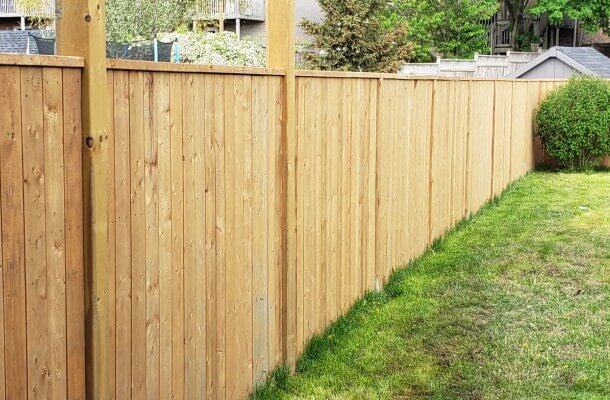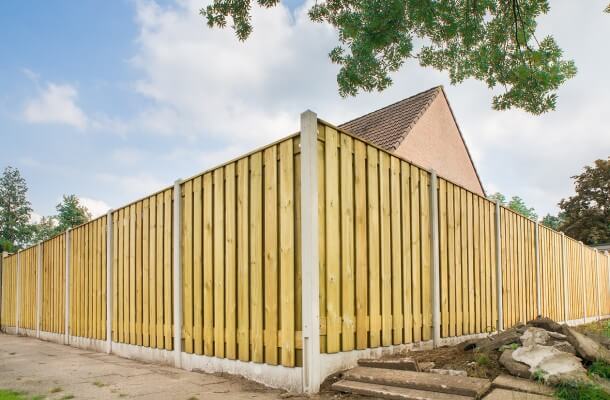When it comes to choosing a fencing material for your home, two popular options are vinyl and wood. Both have their advantages and disadvantages when it comes to appearance, durability, maintenance, cost and more.
This article will provide an in-depth comparison of vinyl vs wood fencing to help you decide which is better for your needs.
Key Factors To Consider
There are several key factors to weigh when deciding between vinyl and wood fencing:
Appearance
Vinyl fencing often mimics the look of wood with a similar grain pattern imprinted on the material. It comes in a wide range of colors and textures, but still has a more artificial appearance compared to natural wood.
Wood fencing provides a classic, elegant look using materials like cedar, redwood, pine or Douglas fir. The natural grain and color variations give wood a distinctive appearance.
Durability
Vinyl is highly resistant to rotting, cracking and insect damage, retaining its strength and appearance over time with minimal upkeep. It does not warp or splinter like wood can.
Wood is susceptible to decay and damage from moisture, pests and weathering effects like sunlight exposure. However, properly treated and maintained wood can still provide years of fence life.
Maintenance
Other than occasional cleaning, vinyl fencing requires little maintenance over its long lifespan. It does not need staining, sealing or painting.
Wood fences demand more upkeep with staining/sealing every 2-3 years and replacing warped/damaged boards over time. Cedar and redwood have natural resistance to decay though.
Privacy
Vinyl’s solid, opaque surface provides excellent privacy and noise reduction for backyards. Some styles have completely closed designs.
Wood fences can have gaps forming between boards over time, reducing privacy. However, designs like alternating board or privacy lattices can increase visual obstruction.
Cost
Vinyl fencing tends to have a higher upfront cost, though it has a longer lifespan than wood of up to 50 years. This lowers the long-term value.
Pressure-treated wood is generally the most affordable fencing material. Though it lasts 10-15 years typically, repairs and replacements drive up long-term expenses.

Environmental Factors
Vinyl is not biodegradable and harder to recycle, raising some environmental concerns around its production/disposal. Manufacturing also uses non-renewable resources like oil and chlorine.
Sustainably harvested wood from renewable sources is more eco-friendly. Un-treated woods can biodegrade at end of fence life. Reclaimed woods are also an option.
Safety
Vinyl fencing does not conduct electricity, making it safer around pools and play areas for kids/pets. It won’t grow mold or splinter either.
Some wood preservatives and treated woods use chemicals like chromated copper arsenate (CCA) that can leach out over time, requiring precautions. Woods can also splinter and grow mold if not properly sealed and finished.
Weather Resistance
Vinyl holds up very well under all weather conditions including rain, snow and UV light exposure. It retains its shape and does not rot.
Wood can crack, warp and decay with exposure to moisture and sun. However, some premium wood types have good weather resistance, such as cedar and redwood.
Pros of Vinyl Fencing
If you decide to go with vinyl fencing, some of the key advantages include:
Low Maintenance
One of the biggest selling points of vinyl fencing is that it requires very little effort to maintain over time. Unlike wood fences that need re-staining every few years and regular repairs from weathering damage, a vinyl fence simply needs occasional washing to keep it looking fresh. You can install it and enjoy the benefits for decades without hassle.
Durability
Vinyl is incredibly durable and retains its quality for much longer than wood. It does not suffer from issues like cracking, rotting, splitting or insect damage. Vinyl fences can last over 50 years, far exceeding the lifespan of a typical wood fence. This makes vinyl a great long-term investment.
Color Options
Vinyl fencing is available in a wide range of colors to match your home’s siding, trim or surroundings. From basic white to grays, browns, greens and more, vinyl allows you to get creative with fence colors that would be hard to achieve naturally with wood. The colors retain their vibrancy over time too since the fences don’t need re-staining.
Privacy
With minimal gaps and its opaque surface, vinyl fencing provides excellent visual privacy and sound blocking for your backyard space. This can be especially beneficial around pools, patios or kids’ play areas. The privacy also boosts security.
Affordability
While vinyl fencing has a higher upfront cost compared to wood, it actually has better long-term value thanks to its longevity and lack of maintenance needs. Factor in the total cost savings over decades and vinyl becomes the more affordable choice over time.
Consistency
Since vinyl fence boards and posts are manufactured under factory-controlled conditions, you get very consistent sizing, color and quality throughout the fencing. This gives vinyl a neat and uniform look compared to wood’s natural variations.
Safety
Vinyl’s non-conductive and generally safer material makes it ideal for safety-minded families. It won’t electrocute around backyard pools. Mold and splinters are also non-issues with vinyl fencing.
Cons of Vinyl Fencing
While vinyl has its advantages, there are also some potential downsides to consider:
Upfront Cost
Vinyl fencing typically costs more initially compared to wood privacy fences. While vinyl recoups the cost over the long run, the high initial investment can be prohibitive for some homeowners.
Artificial Look
Vinyl lacks the natural beauty that many people appreciate in wood. While mimicking wood grain patterns, the look is still obviously synthetic. Those preferring authenticity may find vinyl fencing too artificial in appearance.
Limited Recyclability
One of the most significant environmental drawbacks of vinyl fencing is that it is difficult to recycle. Most vinyl fence components end up in landfills. The manufacturing process also uses non-renewable resources.
Heat Expansion
Vinyl expands and contracts with temperature changes more than wood. This can lead to sagging and deformation over time, potentially leaving gaps between fence boards. Proper installation minimizes this.
Can’t Refinish
Unlike wood surfaces that you can refinish, paint or re-stain, vinyl fences cannot be refurbished if the color fades or you want to change it. The fence would need replacement.
Fewer Design Options
Wood fences come in a nearly unlimited array of styles, from split rail to picket and more. The designs for vinyl fencing are far more limited, often mimicking wood’s most common types. So you have less flexibility in aesthetics.
No Texture
Wood’s natural grain provides texture you can see and feel. Vinyl has an artificial grain texture imprinted on the surface, but it lacks the depth and character of real wood grain that develops over years of weathering.
Pros of Wood Fencing
If you decide wood is the right fencing material for your home, some of the benefits include:
Natural Beauty
Wood has a timeless, classic beauty both in its appearance and texture that vinyl cannot fully replicate. The natural grain and color variations give wood fences depth and character that improves over time.
Design Flexibility
Wood fences come in a huge range of styles, heights, patterns and colors to suit any home and aesthetic. You can easily get custom wood fences made in appealing designs like crosses, lattices and scalloped tops.
Affordability
For homeowners on a tight budget, wood privacy fencing provides an affordable solution. While treated pine is the cheapest, cedar and redwood are also budget-friendly softwoods that resist decay naturally.
Ease of Repairs
When wood planks or posts eventually need replacing after years of use, repairs are easy to handle. Simply swap in new boards that will blend right in with the aged, weathered wood.
Recyclable & Renewable
Sustainably sourced wood is a renewable, eco-friendly resource. Un-treated wood can biodegrade naturally at end of life. Many communities readily accept old fencing for recycling too.
Provides Texture
Wood’s distinctive grain patterns and textures add depth, warmth and character to any fence line. The wood develops a lovely patina over time that vinyl fencing lacks.
Can Refinish
Wood fences can be refinished and coated with stains in different hues over time for an updated look. This allows you to alter color schemes easily. Painting is also an option.
Natural Insulator
Wood acts as an effective insulator for added climate control and sound dampening in your backyard spaces. This enhances privacy while potentially lowering energy costs.
Cons of Wood Fencing
On the other hand, some of the downsides of wood fencing include:
Shorter Lifespan
Even pressure-treated pine only lasts around 15 years typically. Natural woods like cedar may survive 20-25 years before needing extensive repairs or full replacement. Vinyl far exceeds this lifespan.
Intensive Maintenance
While vinyl needs minimal upkeep, wood fences require re-sealing or re-staining every 2-3 years along with periodic repairs, replacement boards and checking for decay or pest damage. This maintenance is continual.
Cost Over Time
The constant re-staining, repairs and overall shorter lifespan mean wood fences cost significantly more than vinyl over the long term despite the lower upfront price.
Warping & Rotting
Wood is constantly exposed to moisture, sunlight and pests that cause warping, cracking, splitting and rotting issues over time. No wood, even pressure-treated, is fully immune to these problems.
Sourcing Concerns
Some wood treatments use chemicals like arsenic concerning to many homeowners. Responsible sourcing of lumber without excessive deforestation is also important to consider.
Can Develop Mold & Splinters
Untreated, aging wood that retains moisture can develop potentially hazardous mold. Older wooden fences also pose risks of splinters around pets and kids. Neither issue occurs with vinyl.
Inconsistent Appearance
Since wood is a natural product, there will always be variations in grain, color, size and spacing from board to board. This can create a more inconsistent, irregular look compared to neat vinyl fences.
Conducts Electricity
Wood fences conduct electricity, raising safety concerns around backyard pools and other wet areas. Electrocution is possible with improper wiring or downed power lines touching wood.
Conclusion
When choosing between vinyl or wood fences, key factors to weigh include:
- Appearance – Vinyl mimics wood while wood provides natural beauty
- Durability – Vinyl lasts longer while wood is susceptible to decay
- Maintenance – Vinyl needs much less while wood requires regular upkeep
- Cost – Vinyl has higher initial cost but lower lifetime cost
- Sustainability – Wood is renewable but vinyl is not recyclable
- Safety – Vinyl has fewer risks but wood can pose concerns
Ultimately, vinyl makes a great choice for low maintenance and longevity while real wood offers unparalleled beauty. Assess your specific needs and property considerations to decide which fencing material is right for your home.
With proper installation and care, both vinyl and wood fences can provide privacy and enhance curb appeal for decades to come. Contact us today for installing your fence in Wichita Falls.



